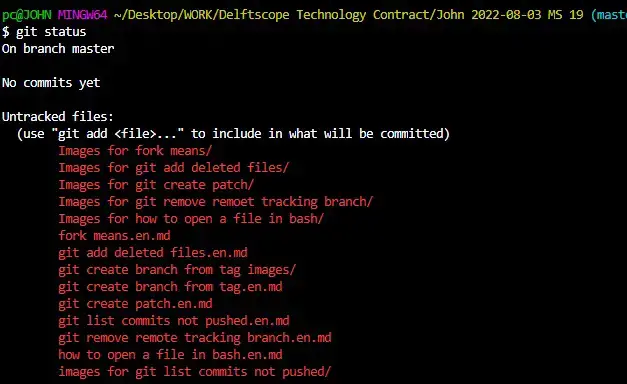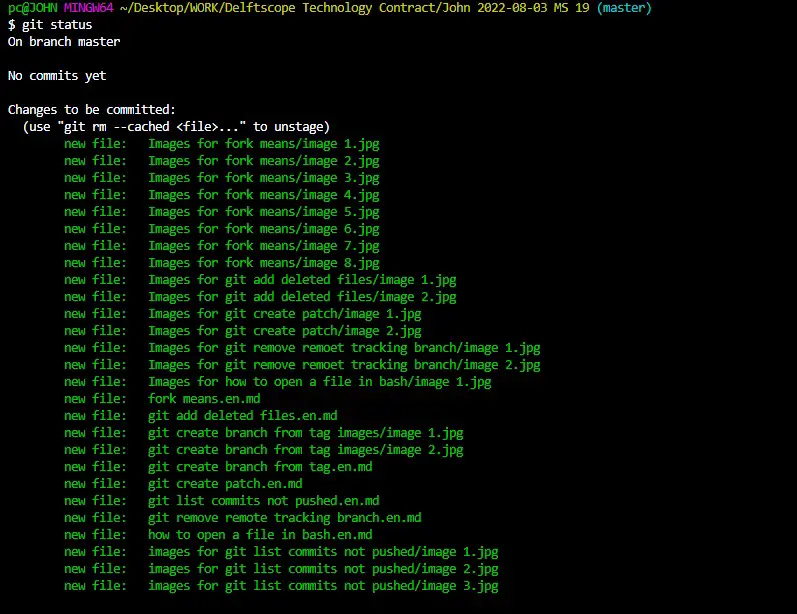Set the folder as a Git Repo and push it to the remote
This article shows you how to convert local folders into Git repositories and push them to a remote repository.
Git version control and GitHub will provide us with all the tools we need to get the job done. Without further ado, let's get into today's agenda.
Set the folder as a Git Repo and push it to the remote
The first step is to set up an empty remote repository. In this case, we decided to use GitHub.
If you're not sure how to set up your remote, follow these steps.
- Go to your GitHub account and navigate to the Repositories tab.
- Click New to create a new repository. Name your repository and click Create Repository.
Do not include the README.md file. Copy the link to the repository; we will need it in the next step.
Open Git Bash and cd into the directory where you want to create the Git repository and initialize the Git repository using the git init command.
Here is an example.

NOTE: If you are not using GitHub as your remote, use
git init --barethe command.
Now that our directory has been converted to a Git working directory, we can stage all of our files for commit. Use the git add command to add all of our files and folders to the index.
Before we stage our files, let's take a quick look at our working directory.
$ git status

We can see that Git is not tracking the files and folders that exist. Let's add them to the index.
$ git add .
Let's check our indexes.

Our files are now being changed to commit. We can run the command below to commit the changes and enter a commit message.
$ git commit -m "Initial Commit"
Next, we link our local repository with the remote GitHub repository. Remember the link we copied; it comes into play here.
This is how you connect the two.
$ git remote add origin https://github.com/Wachira11ke/Git-Tutorials.git
This will allow us to push and fetch changes from the remote. We can git remote -vconfirm this by running the command.

Now we can push our changes to the remote repository. Since we are pushing for the first time, we will use the command with the -u flag git push.
This will instruct Git to push our changes to the remote and set up our branch to track the remote branch.
$ git push -u origin master
The output is as follows:

What does set up to track mean?
When we set up a branch to track a remote branch, we can automatically push and pull without specifying the remote branch. You can use git remote -vvto check your remote tracking branch.
We can convert a non-empty local directory into a Git repository and push the changes to the remote. If you do not plan to use GitHub as a remote server, be sure to use git init --barethe command.
For reprinting, please send an email to 1244347461@qq.com for approval. After obtaining the author's consent, kindly include the source as a link.
Related Articles
Git installation and establishment of local warehouse service
Publish Date:2025/04/05 Views:89 Category:Git
-
Git is a distributed version control system: the client does not only extract the latest version of the file snapshot, but also completely mirrors the original code repository. It has the following advantages: a. Since every extraction oper
git remote operation——multiple remote repositories for one project
Publish Date:2025/04/05 Views:131 Category:Git
-
Multiple remote repositories for a git project In our git project, the command to operate the remote repository information is $ git remote # 查看当前所有的远程仓库的名称 $ git remote -v # 查看远程仓库的名称和远程仓
Git cherry pick command usage
Publish Date:2025/04/05 Views:190 Category:Git
-
git cherry-pick is a powerful command that allows us to select an arbitrary Git commit by reference and attach it to the HEAD of the current working branch. Cherry picking is the act of picking a commit from one branch and applying it to an
Comparison between Git merge and Git rebase
Publish Date:2025/04/05 Views:171 Category:Git
-
The git rebase command may seem like Git wizardry to beginners, but if used carefully, it can actually make life easier for your development team. In this article, we compare git rebase with the related git merge command and identify all th
How to fix Git error Error: src refspec master does not match any
Publish Date:2025/04/05 Views:124 Category:Git
-
When using Git, we may encounter the error "src refspace master does not match any". Here's what the error means and how to fix it. What does src refspec master does not match any Mean in Git mean? We may encounter this error when we try to
Rebase local branch when pulling changes from remote repository branch in Git
Publish Date:2025/04/05 Views:144 Category:Git
-
This article will cover the basics of rebasing your local branch when pulling changes from a remote repository branch in Git. We use the version control system Git to track changes made to files. We commit changes in a local branch in our l
Undo Git Stash
Publish Date:2025/04/04 Views:187 Category:Git
-
This article explains how to make and save changes to a repository. Git allows you to save changes locally and push them to a server when needed. In Git, we don't use the term save , but commit . We use git add , git commit , and git stash
View a list of cache entries in Git
Publish Date:2025/04/04 Views:59 Category:Git
-
We often need to pause our work and focus on something else in our development environment. Therefore, we may need to temporarily save our current work and focus on a different one. We may want to resume our original work later. git stash T
Git stores specific files
Publish Date:2025/04/04 Views:115 Category:Git
-
This article will cover storing changes to only specific files in Git. In Git, when we make some changes in our working tree, we may have some changes which may or may not be staged in our local repo. We may now wish to save these changes f

